MOISTURE MATH
BY TREVOR BACQUE • PHOTOS BY ANTHONY HOULE
With certain pockets of Western Canada being dealt losing hands at harvest year after year, grain drying is moving from a “nice to have” to a “need to have.”
Starting in 2016, wicked fall weather has plagued thousands of farmers. Today, with many opting for straight-cut options, the wait time to get into fields becomes all the more dangerous when unpredictable weather may strong-arm a farmer’s harvest. As a result, grain sits, and sits, and sits some more. Meanwhile, farmers continue to bite their nails, stress mounts and tough financial questions begin to loom.
Any farmer will attest to their desire of a safe, uneventful and timely harvest. However, with weather patterns and farming practices changing, many choose to stop waiting and start pushing. In Alberta, it’s most common to see wheat, canola and malting barley as the top crops to be tossed in the dryer. At times pulse crops may be dried, too.
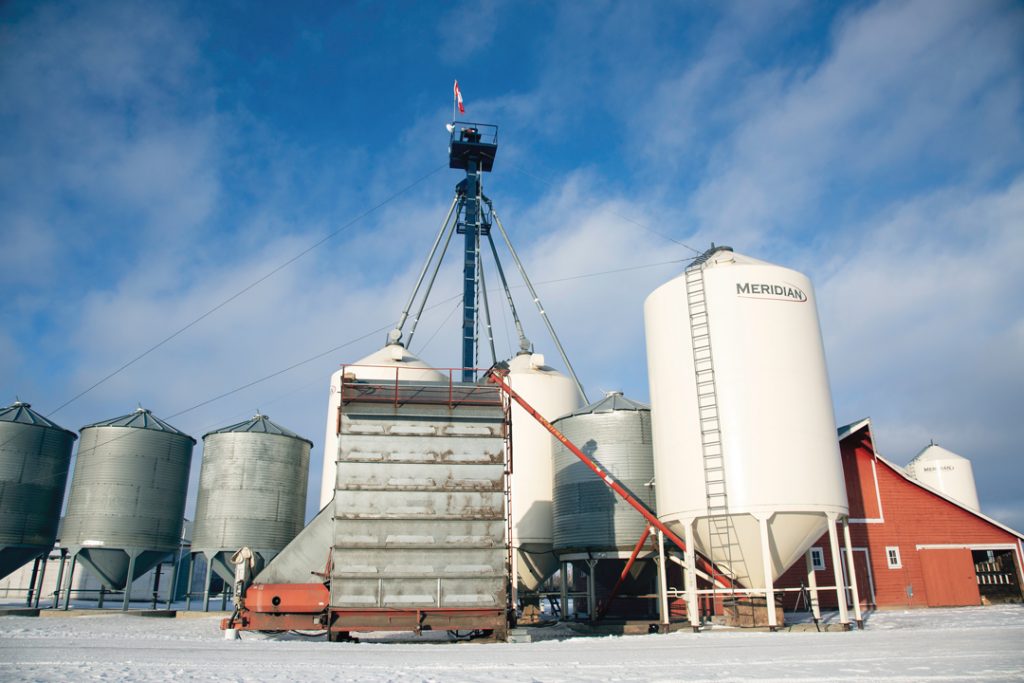
FARMER FOCUS
Scott Keller never used to dry grain above 19 per cent at his New Norway farm. However, the last three years the weather forced his hand and drying became necessary to salvage the crop. He has handled the job with a 1995 IBEC Vertec 5500 that has a 700 bu/hr capacity. It usually dries 400 to 500 bushels at a time, but can be as low as 150 if the grain is sopping wet. Since 2016, Keller has dried more than 500,000 bushels of his grain, which, on average, is about 80 per cent of his annual crop.
Twenty-four years ago, Keller’s father paid $30,000 for the dryer and Keller sees no reason to mess with a good thing. They have two wet bins—4,000 and 2,200 bushels—and four dry hopper bins with a total capacity of 15,000 bushels. His final storage bins can hold 84,000 bushels in addition to his grain bagging, which is anywhere from 50,000 to 90,000 bushels. So far, it’s a good system at his 2,500-acre farm.
“We need about three of those four dry bins every day,” he said, adding they combine anywhere from 8,000 to 12,000 bushels under favourable conditions. “Once you get a dry bin full it takes a good eight hours to cool to a safe temperature [under 20°C] with an aeration fan. With four dry bins we will have two full and cooled by next morning. The third bin that we dried grain into through the night won’t be cool enough yet. So, by having four dry bins we can leave that third bin cool the next night so we don’t have any storage issues caused by warm grain. Having extra dry bins gives you that flexibility to get the grain cooled and in good condition.”
He operates single-phase power on a 25-Kilovolt-Amp (kVA) transformer and has never had an outage, even when running his dryer, which pulls 75 amps and powers four aeration fans. “The only thing I didn’t try to do was some welding,” he said with a laugh. “Never yet have we been limited with our current power capacity.”
Between last August and November, Keller’s total power bill was $2,107. Of that, $1,335 was directly related to his dryer and aeration fans. His utility costs of power and natural gas to dry his grain tallied 5.6 cents per bushel, four cents to natural gas and 1.6 cents in power. The previous two years his total was four cents per bushel, but the cost of doing business has increased. Overall, it requires one penny per bushel, per point of moisture in the drying process.
In addition, Keller must also account for the carbon tax, which he says adds $1/acre onto his drying costs.

His August 2018 gas bill was $4.537 per giga joule, of which gas was $1.10, transportation was $1.92 and $1.517 was the carbon tax. In September, his gas costs rose another 10 cents. While his sentiments towards the carbon tax are not as sharp as others, he does wish the province would recognize his own contribution to sequestering carbon.
“I’d be happy to pay carbon tax—no problem doing it—if zero-till farmers like myself actually got paid fair market value for the carbon we sequester in the ground,” he said. “That could turn into, by calculations I’ve done, a $30 to 50 per acre revenue stream for us. I can understand why the government wouldn’t jump at that.”
Keller, like others, custom dries grain, charging $75 per hour plus gas, which fluctuates between $5 and $7, depending on outside temperature, crop type and its moisture content. He often sees grain that’s tougher than normal, too. “Some guys don’t have options when they’re taking off wheat over 20 per cent, canola over 15 per cent; elevators aren’t ones to deal with that,” he said. “There’s not a lot of wear and tear on our system and I know our costs. It’s worth my time to do it.”
Despite knowing his business costs, Keller cannot get his head around three-phase setups operating off a generator set (gen-set). “[Some farmers] are probably spending four to five times more on power than what I am,” he said, adding that his fuel cost is $7.20 per hour while others hover around $30 per hour in diesel.
“From what I know about costs for fuel, you really better pencil that out better,” he said. “Guys say gen-sets on three-phase is better and all components are cheaper. You’re trying to save a few thousand now, but what are your costs long-term? I don’t think it’s always that well thought-out.”
Keller recommends a thorough analysis of the farmyard to determine the best physical setup for the system. He kicks himself due to his tight laneway, which his dryer directly butts up against. “It’s handy for pulling in when you’re loading, but that’s about it,” he said.
He also recommends looking for areas where you can eliminate manual labour. Keller said there are two types of farmers out there: ones who own a dryer, plan on using it and do use it annually and those who own a dryer and only use it if absolutely necessary. The latter simply befuddle him. “Those guys are typically on the low-tech side and they typically have to babysit it 24/7 and you can understand why,” he conceded. “You have to get some sleep sometime.”
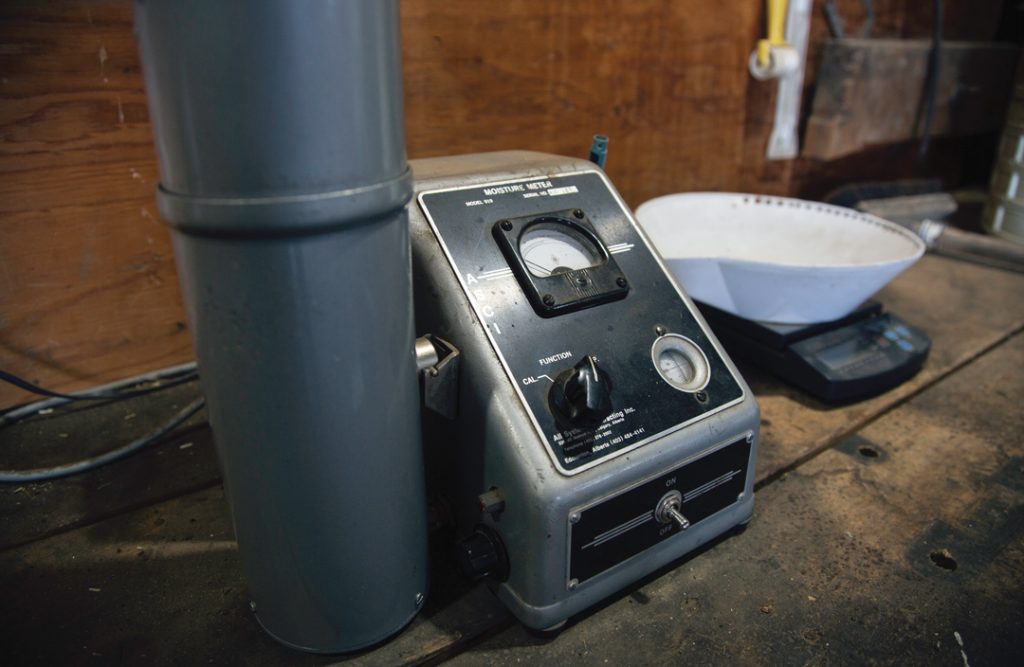
Further south, just off The Queen Elizabeth 2 Highway near Innisfail, Scott and Wade McAllister focus on malting barley at Antler Valley Farm. They manage 4,000 acres, including 1,450 of malt barley, their prize crop.
They don’t wait for favourable skies to begin harvesting these days, either. They straight cut their barley in mid-to-late August and immediately begin drying. They recently upgraded their setup, too. In the past, the brothers were able to dry down 275 bushels per hour. However, that was when the farm was one-quarter the size it is today. They recently sold their old GSI dryer to a farmer near Kindersley, SK., purchasing a new setup from the same company. The big difference? The old system typically handled 275 bu/hr, while the new dryer is capable of handling anywhere from 1,000 to 1,300 bu/hr.
Their new stack dryer setup carried a cost in the mid-six figures, which includes the dryer itself, two legs, three bins, concrete pads for everything to rest on as well as electrical wiring and a diesel-power gen-set. They saved additional money by taking care of what manual labour they could ahead of time.
They chose a stack dryer because it’s easier on malt barley as plenum temperatures don’t run as high, keeping the germination intact. Their old dryer was short and single-tier, which means it took longer to dry grain due to the dryer’s size, but did maintain a consistent temperature throughout. The new stack dryer setup is taller and longer, and since hot air rises, the grain can be dried using a lower temperature. The three-burner setup can handle any combination of hot and cold, depending on what crop they’re drying as well as what the outside temperature is and how many points of moisture they plan to remove from the grain.
“In August, when the outside temperature is warmer, we’ll have all three fans on heat and the grain will just cool in the bin,” said Wade, who is Alberta Barley’s region three director-at-large, he added it’s the most economic month during which to dry grain. “Later on, when we’re drying lots in October, we’ll do the first two burners heating and the bottom one cooling, so we’re not getting condensation when we’re dumping it hot.”
The brothers’ dryer is top of the line, but they did pass on the fully-automated smartphone control add-on since their dryer is viewable from all points in the yard and someone is inevitably around moving grain.
The dryer, a four-fold capacity upgrade, runs off a three-phase, 125 kVA diesel gen-set. McAllister looked into having three-phase brought into the farm yard and discovered it would have cost “hundreds of thousands of dollars.” Beyond that, the monthly distribution charges would have been around $400. By using a gen-set, he’s not paying a distribution charge for the months he’s not using the dryer. In addition, the gen-set serves as a backup power supply for the farm itself, should there ever be a power outage.
A three-phase gen-set does carry a cost, though. New units can retail for $50,000 while even second-hand machines can run as much as $30,000 depending on its hour count and condition.
The gen-sets run on gas. Since marked fuel is exempt from both the provincial and federal carbon taxes, so farmers can utilize it for grain drying. “We feel that because you don’t have to pay carbon tax technically on farm fuel, we can use our farm diesel to burn in the generator,” he said, adding that for a 1,200- to 1,300-bushel load in the new dryer, it will take about four litres of diesel, the same amount their older, less efficient dryer needed to dry 250 to 300 bushels.
However, they cannot escape the natural gas cost nor its attached
carbon tax. His natural gas bill ended up being about $4,500 for six weeks of use this past fall to dry 70,000 bushels of grain. Of that total, the carbon tax and gas each accounted for $1,350 while the remaining fees went to distribution and administrative costs.
“For the last eight years we ran a dryer, we never had that massive tax on there. The gas price is almost the same as the carbon tax … it’s almost one-to-one,” he said. “We didn’t know how much we were going to dry … and that’s right off our bottom dollar. That’s right out of the profit that we’re making. Drying the grain is already costing so much cents a bushel, and then you add this carbon tax onto it, which means absolutely nothing. It’s frustrating. I’m not going to change it.”
The McAllisters spend anywhere from six to 10 cents per bushel to dry grains, plus man hours as well as general wear and tear, depending on the crop and its relative moisture content when they begin drying grain. “At the end of the day, it’s pretty cheap considering you may be gaining grades and up to $1 per bushel on malt quality,” he said.
This past year all their barley made malt. It was combined Aug. 17 and was dried shortly thereafter from 16.5 per cent moisture down to the desired 13.5 per cent spec. “Even in a dry year, we’ll still fire it up and pull malt off at 16 to 18 per cent,” he said. “The cost of fuel is a fraction of the fuel you’ll use when it’s cold out. The sooner you can get harvest done, as long as the crop is naturally mature, the earlier you can get field work done and get fields prepared for next spring. Malt is such an unforgiving thing that you need to make sure you do everything you can to get it off.”
With the difficult year that it ended up being in central Alberta, McAllister confidently estimated he and brother Scott saved malt grade on every last kernel, all thanks to the grain dryer. “If I was thinking about a third combine, I’d buy a dryer instead,” he said. “If I was a banker, I’d give you money for a dryer way before I’d give you money for a combine.”
In addition to drying their own grain, they custom dry for anyone willing to haul to them. They charge $100 per hour plus fuel, just to keep the math simple. They even custom dried for two nearby elevators back in 2016. A third came knocking, too, but the brothers were booked up.
“Every year we do a little bit of custom drying, but with this new dryer, I think a lot more neighbours are going to be a lot more interested because they can pretty much haul a load in and by the time they get back with another load, it’ll probably be done and they can do round trips,” he said.
He also recommends natural gas over propane because it’s often easy to access, costs less and burns more cleanly.
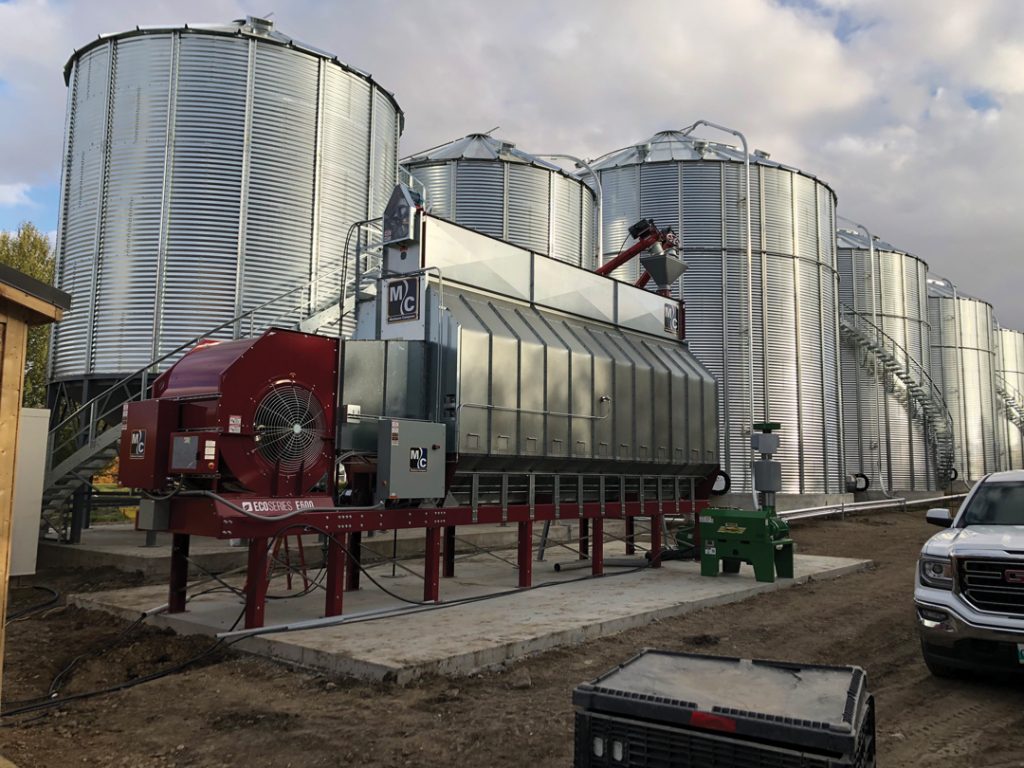
RETAIL PERSPECTIVE
The trend that sees farmers setting up on-farm drying systems will not reverse itself anytime soon if you ask Dave Wall. The CEO of Wall Grain said Western Canada is in a great flux when it comes to post-harvest practices.
“They can combine earlier and go longer with harvest and go harder at the crop if the weather is looking bad,” said Wall of Prairie farmers. “Because of the crazy harvest, not just this year, but also 2016, we’re seeing more and more people want drying systems. They did before, but now it’s not just an emergency tool. It’s something that’s part of their long-term management plan.”
Wall’s company gets all kinds of requests, but usually nothing below a 500-bushel capacity. If it’s less than that, farmers often search the used market first. Regardless, Wall labels the dryer as “the cheap part of the whole system.”
Wet and dry bins, a blower system, bucket elevator, augers or legs, cement, electrical wiring and other components all carry a cost and $500,000-plus price tags are not hyperbole. Then there’s power. “Most producers are on single-phase [power], but most of the dryers and systems require three-phase, so most people will go and buy gen-sets,” he said.
For farmers looking to set up a drying system, they better have done their homework because it could take months to have everything in place, depending on the dryer setup. Wall says that contingent on size, his company could only handle about 10 to 20 more installs in 2019.
“There’s just so many things that have to be done, including financing. Planning for a grain dryer system should be done one to two years in advance, not this year,” he said. “Many farmers bought dryers in a panic mode and still don’t have them set up.”
Jayde Klassen is a GSI dryer technician at Wentworth AG and said the Alberta marketplace has really opened up in the last few years and people are opting for convenience over everything else. “A lot of the guys are getting rid of their old batch dryers and are moving into a more automated system where they can basically push start and walk away and let it run,” he said.
Klassen believes it’s being done for ease of use, but also to save money and give farmers a chance to be at home more, or simply do other tasks that don’t involve sitting around staring at their dryer.
Alberta farmers may waffle between a dryer and a shiny new combine, but Klassen said if you have a dryer, there’s no need for the second combine since you can be in the field much earlier, just like the McAllister brothers.
He also sees more interest in top-dry units as opposed to portable units, which are still seen in great number across the Prairies. “If you’re looking at buying a dryer, or bin, you might as well combine the two and do both there,” he said. “A lot of guys in the United States have been switching over to top drys and we’ve seen guys in Manitoba, Saskatchewan and Alberta start to explore their options with them as well and realize the cost savings with them.”
A top-dry dries the grain, dumps it, dries another load, dumps it onto the floor below and recycles the heat through the aeration fan. Then, when done, you use the bin as storage.
Above all, farmers must consider a large-sized setup right from the get-go. The cost is higher, but not too much higher, when initial prices are considered, according to Klassen. “The cost to go bigger isn’t significant compared to being held up at harvest when your dryer can’t keep up to the yields you’re doing or if you get another combine,” he said.
Echoing Klassen’s sentiments is McAllister, who would take a dryer over a combine seven days a week, believing there’s no need for more combines when you have a dryer and greater control of your farm and, ultimately, harvest.
“I think this new dryer is going to change the way we farm,” said McAllister. “We’re going to farm before Mother Nature says we’re ready. I think it will be a good thing. Talk to me this time next year and see.”
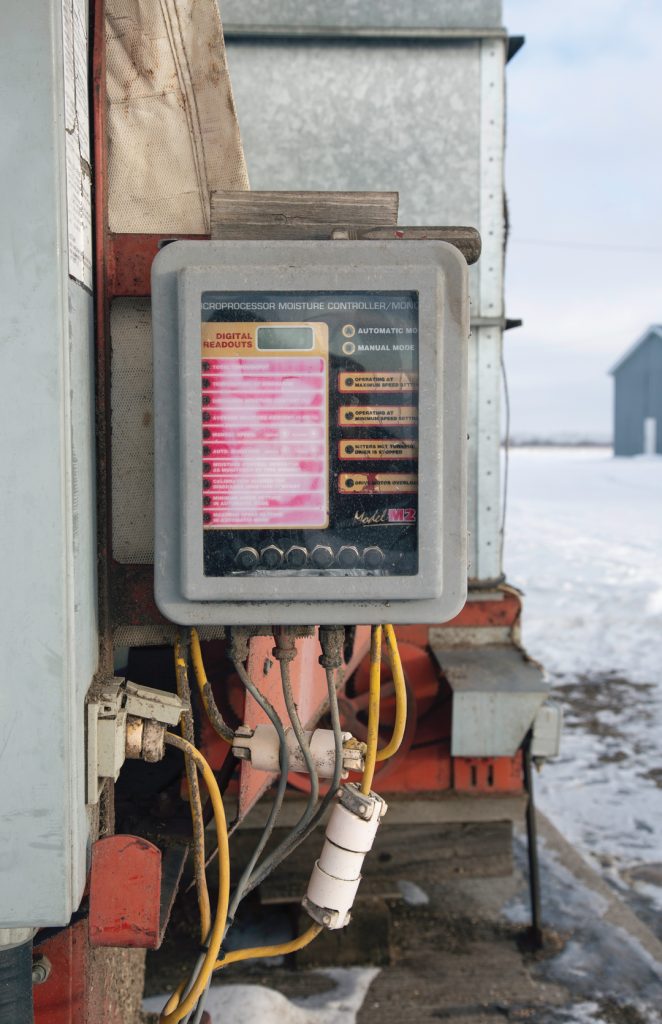
PROVINCIAL KICKBACK FOR DRYER IMPROVEMENTS
Farmers who have so far held off upgrading or retrofitting their grain dryers may have the last laugh after the provincial government recently announced funds for farmers to bring their units up to 2019 standards.
Under the Farm Energy and Agri-Processors (FEAP) program, farmers and the government will split costs on upgrading various components of their dryers to high-efficiency standards.
The government’s overall goal is “to encourage energy management which will result in cost savings, energy conservation, and ultimately, reduced greenhouse gas emissions.” Within that, another aim is to reduce carbon emissions while keeping farmers profitable after many difficult harvests have cost them thousands of dollars in lost profit.
“For many producers this year, grain had to be dried once it was in the bins,” said Oneil Carlier, the province’s agriculture minister. “Drying grain can be an unexpected expense and some producers were concerned about the cost of the carbon levy as it relates to natural gas and propane.”
Many brand-new components available to farmers at half price include heat exchangers, pre-heat systems utilizing exhaust air, variable-speed drives on electric motors and gravity-fill roofs instead of power-levelling augers.
A number of retrofit parts will also be eligible for the government discount. These include hopper covers, automatic moisture controllers, PTO to electric motor conversions and new high-efficiency burners. Items such as conveyors, legs, aeration fans and bins are not eligible for the kickback.
The maximum money an applicant can receive per year is $250,000. Other areas of the program are all designed to make farm operations more energy efficient, from wall insulation and new lighting to natural gas boilers and furnaces.
A full list of available funding is valid from Dec. 1, 2018, until March 31, 2019. Farmers are encouraged to check online at agriculture.alberta.ca or call 403-310-3276 for updated information on the program’s status.





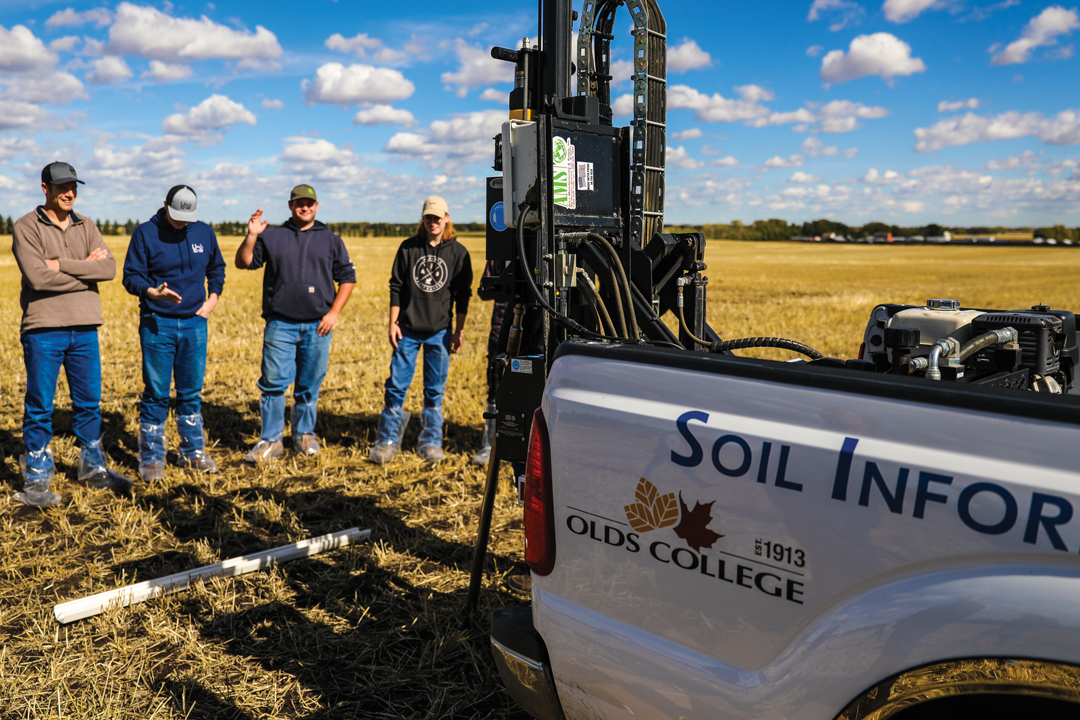

Comments